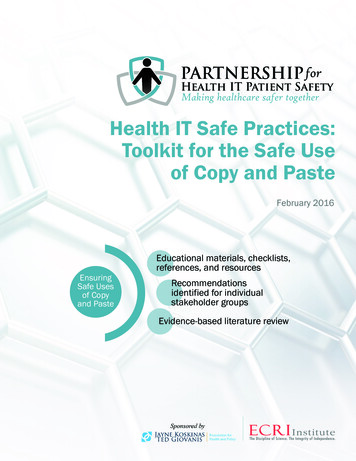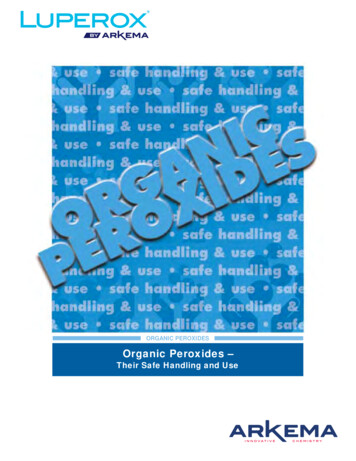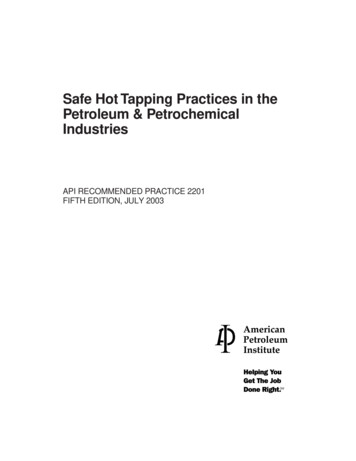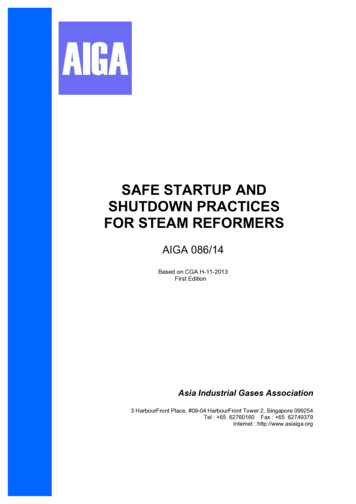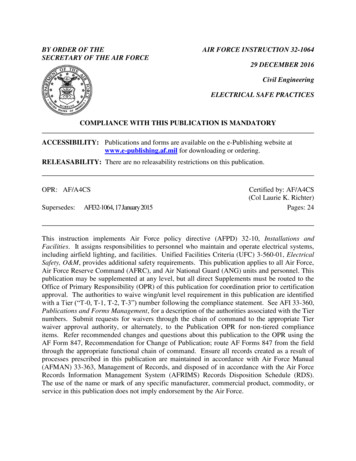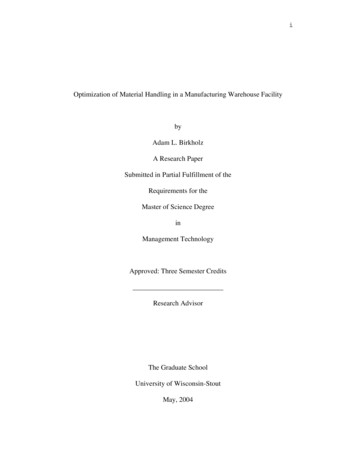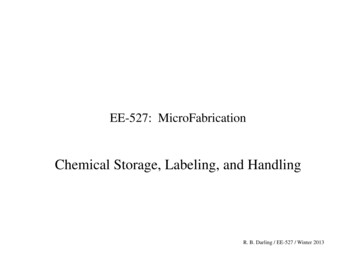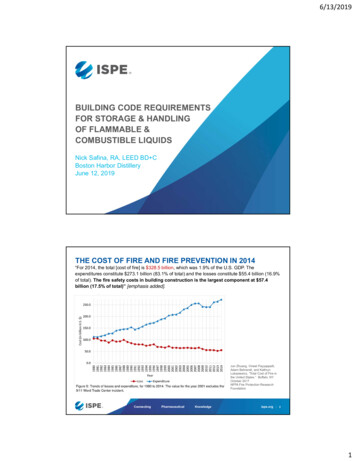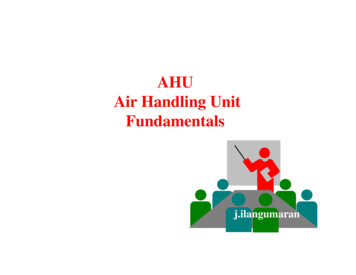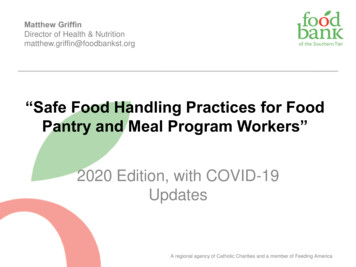
Transcription
Matthew GriffinDirector of Health & Nutritionmatthew.griffin@foodbankst.org“Safe Food Handling Practices for FoodPantry and Meal Program Workers”2020 Edition, with COVID-19UpdatesA regional agency of Catholic Charities and a member of Feeding America
Foodborne IllnessAffects about 48 million people and causes about3,000 deaths each year in US Another 128,000 people are hospitalized Caused mainly by pathogenic viruses & bacteria BacteriaViruses
Foodborne Illness & EmergencyFood Programs Many of the people you serve are especiallysusceptible to foodborne illness– Low-income persons, elderly, children, pregnant women,people with chronic diseases Illness can be prevented with safe measures You play a very important role!
What are the big food safety concernsat Emergency Food Distribution Sites? Unsafe products– Damaged, leaking, or exposed cans, jars, & packages Cross-contamination– Unclean areas, pest infestation– Contamination of food by non-food items– Raw food dripping on ready-to-eat food Time temperature abuse– Potentially hazardous foods not stored at proper temperatures– Improper thawing, cooking and cooling Poor Personal Hygiene– Ready to eat food handled by soiled hands or by ill persons
Safe Food Starts with You!Clean handsHealthy WorkersClean work attireClean work areaDo not work if you are feeling ill!Especially if nausea, vomiting or diarrhea!
COVID-19 Considerations
COVID-19 Considerations: Worker Screenings Have you knowingly been in close or proximate contact in thepast 14 days with anyone who has tested positive for COVID19 or who has or had symptoms of COVID-19? Have you tested positive for COVID-19 in the past 14 days? Have you experienced any symptoms of COVID-19 in the past14 days?Adapted from the Food Bank of the Southern Tier’sVolunteer Health & Safety unteer-healthsafety-guidelines/
Proper Handwashing Procedure1Wet hands with runningwater as hot as you cancomfortably stand (at least100 F/38 C).4Rinse thoroughly underrunning water.2Apply soap. Use enough tobuild up a good lather.53Vigorously scrub handsand arms for 10-15seconds. Clean underfingernails and betweenfingers.Dry hands and arms witha single-use paper towelor warm-air hand dryer.Use paper to turn offfaucet.Serv Safe 5th edition
Hand Washing Trouble SpotsCourtesy of Food Bank of Central NY
When to Wash Your HandsAfter: Using the toilet Sneezing Handling garbage Eating food ordrinking beverages Going from one taskto another5-7
Handwashing Study, 2014 3,749 people observed in public restrooms What percentage washed their hands for at least 20 seconds? On average how long did people wash their hands? What percentage did not wash their hands at all? Handwashing Practices in a College Town Environmenthttps://msutoday.msu.edu/ /pdf/assets/2013/hand-washing-study-1.pdf
Are they the same? Hand washing versus Hand Antiseptics Hand antiseptics should only be used afterhandwashing, not in place of it.
Clean and sanitize food contactsurfaces Dishware, utensils, food preparation surfaces,and beverage equipment Sanitizing Bleach solution of 1 tablespoon ofbleach per 1 gallon warm water
COVID-19 Considerations:Clean and disinfect frequently touched surfaces Door knobs, equipment handles, counters, and grocery carthandles etc. Common disinfectants Lysol, Clorox wipes, bleach
Breakout Room What is one action your food program is taking to ensure safefood access during the COVID-19 pandemic? Take 1 minute to share what you are doing with others in thebreakout room
Potentially Hazardous Foods
In the food prep, storage or distribution area No eating No drinking No smoking
Meal Programs: Do not touch theseitems with bare hands! Prepared, fresh produce served raw Salads Cold meats and sandwiches Bread, toast, rolls, and baked goods Ice served to guests Any food that will not be thoroughlycooked or reheated after it is prepared Ready to Eat Foods!
Questionable FoodKeep your eyes open for: Home canned food Sharp dents Bulging Rust Broken inner sealsKnow your food sources!When in doubt, throw it out!3-1
Receiving & Evaluating Food
Bill Emerson Good Samaritan FoodDonation Act– “To encourage the donation of food and grocery productsto nonprofit organizations for distribution to needyindividuals” Protects donors from:– liability when donating to a non-profit organization;– civil and criminal liability should the product donated ingood faith later cause harm to the recipient; Defines gross negligence that could lead to liability
Receiving Food Check for abnormal odors, pests, ice crystals(refreezing?) Packages should be sound and undamaged Meat, poultry, seafood, and dairy products at40 F or below! Check temperatures with a thermometer3-11
Canned FoodDo not accept: Home canned food Cans without labels or illegible writing3-1
Evaluating Canned Food Discard cans that have Swollen or bulging ends Sharp dents on top or side seam Holes, fractures, or punctures Rust with severe pitting orthat cannot be easily rubbed away Severe dents parallel to the rim Buckled or pinched ends3-2
Evaluating Food inBottles or JarsDiscard bottles or jars that haveany of these defects: Chipped necks and threads; cracked glass Leaking or discolored product Crooked lid or vacuum (pop-up) button raised Evidence that cap has been opened; inner seal,tear-away or break-away ring, tamper-evidentseal, or shrink band missing or broken Broken cap3-5
Evaluating Bagged and Sacked FoodDiscard bags or sacks with: Rips, tears, or holes Rodent or insect damage Unknown stains or contaminants Missing or illegible label3-6
Evaluating Boxes with an Inner Bag Look for contaminants orwatermarks on the box Look at inner bag—discard if it is: Torn, leaking, or contaminated Has imperfect or leaking seals Has moldy or foreign objects inside Has signs of insects present3-8
Evaluating Boxes Withoutan Inner Bag Do not use if opened Look for contaminantson box Look for insects,insect skins, webs,or chaff3-9
A Local DonationBeatrice is closing the pantry for the day when a gentlemanwalks in with extra cabbage, potatoes, and frozen meat fromhis farm.What should Beatrice do with the food?Why?
Handling Walk-in Donations Remember the potentially hazardous foods– Should come from approved sources (Ex.inspected by Ag and Markets)– Ex. Ask donor: Where do you have your meatprocessed? Check conditions and temperatures of product.Check for evidence of thawing Look for any discoloration
Mac and Cheese: Late for the DateBob is helping sort food from a food drive at the food pantry.He notices that a case of boxed Kraft macaroni and cheese haswritten on it “Best by January 1, 2020.”What should Bob do with the mac and cheese? Why?
Can we use food after the“sell by” or “best by” dates? Yes! See updated handout! “Sell by”- last day product can be offered for sale “Best by”- last day manufacturer can guaranteehighest quality Many products are safe beyond date on package Proper storage and sound container are important
What if an item has no date? Check container for any contamination,spoilage or significant damage
Food Recalls Voluntary removal of product from commercewhen there is reason to believe that it may beadulterated or misbranded FBST receives notices from Feeding America FBST informs agencies of recalled itemsdistributed by FBST or through local sources(listserv email, phone calls) – see sample recallalert foodsafety.gov/recalls/recent/index.html
Why not bulk up on chicken?Rita places her Food Bank order every Wednesday for thefood pantry. This week she is planning to offer whole chickensso her families can have a nice meal during the holidays. Shenotices that the chicken is only offered in 12 pound bulkcases- all the chickens are frozen together. She had hoped forindividually wrapped chickens.What should Rita do? Why?
Repacking Policy Ability to repack foods requires a speciallicense from NYS Department of Ag andMarkets Food pantries are not licensed by Ag andMarkets to repack Repacking unprocessed agricultural productssuch as onions, apples, and potatoes does notrequire a license
Receiving Food Activity Would you distribute/use this item at youragency? Why or why not?
Safe Food StorageTime
Dry Storage Guidelines Maintain temperature between 50 F and 70 F Best practice to maximize the shelf life ofproducts, but is not always attainable Keep food at least 6 inches off floors and away fromwalls and ceilings Avoid overcrowding Promotes air circulation4-1
Dry Storage Guidelines (cont.) Label receiving date of products Ensure proper rotation- oldest food out first Rotate stock at least every 3 months Store chemicals separately, away from food
Ante Up for Pest ControlThelma is cleaning the pantry when she notices quitea few ants moving across the floor of the foodstorage area.What should Thelma do? Why?
Pest Control Clean area. Remove any food or other materialsthat may be attracting ants See where ants are coming from; Deny access.Observe. Do not spray chemicals or open bait stations. Closed bait stations, pest strips and glue boardsOK Work with pest control operator
What’s wrong with this picture?
What’s wrong with this picture?
Refrigerated And FrozenFoods Store refrigerated food at 40 F or below (Keep fridge at 37 F) Store frozen food at 0 F Equip all units with internal thermometers Record temperatures as frequently as possible on logsheets4-3
The Temperature Danger Zone Range of temperatureswhere bacteria grow rapidly Between 40 and 140 F Includes all room andwarm temperatures6-1
Four Hour Rule If potentially hazardous food is held in thetemperature danger zone for more than 4hours, it must be thrown away.
Feeling the Heat?Main Street Pantry is offering one-pound packages of frozensausage today. Marcia, the worker in charge of the frozenfood sets 20 packages out on the distribution table at 9am. At1:30pm, the pantry closes and she put the remaining 2packages back in the freezer.Will the two packages be safe to eat?Why or why not?
An Open and Shut Case?Millie comes to work at the kitchen on Tuesday and findsthat the refrigerator door was left ajar all night. Thethermometer reads 60 F. The refrigerator contains apples,mozzarella cheese, beef sirloin tips, celery, and slicedcantaloupe. What should Millie do with the foods?What should Millie do with the food? Why?
When the power goes out . Refrigerator (closed): Food good for 4 hours Freezer (closed)– Half-full: Food good for 1 day– Full: Food good for 2 days If the power will be out for more than 2days .
Safe Food Preparation
Don’t be chicken!Tell us your answer! Stella cut up chicken for dinner on a plasticcutting board before cooking it. She thenrinsed the cutting board and used a clean,sanitized knife to cut up lettuce and tomatoesfor a salad. Is the salad safe to eat?
Preparation Guidelines Rinse fresh produce Clean & sanitize cutting boards frequently;avoid cross-contamination Use separate, clean utensils for tasting food, ifnecessary Thaw, cook, and reheat properly
Four Acceptable Methodsof Thawing Food ProperlyIn a refrigerator, at 41 F (5 C)or lowerAs part of the cooking processSubmerged under runningpotable water, at a temperatureof 70 F (21 C) or lowerIn a microwave oven, if the foodwill be cooked immediatelyafter thawingNever thaw meaton the counter!!!!
Cooking TemperaturesFood ProductMin. TemperaturePoultry, stuffing, all stuffed meats165 F(15 sec)Ground beef, sausage155 F(15 sec)Pork and beef chops or steaks145 F(15 sec)Shell eggs, fish145 F(15 sec)Leftovers165 F(15 sec)Use a thermometer to check temperatures!6-10
Thermometer Facts Follow the manufacturer’sinstructions for proper use Handle with care and store properly Prevent cross contamination by cleaning andsanitizing between each use Check periodically for accuracy and calibrate ifnecessarySensing Area7-1
Thermometer CalibrationIce Method Place crushed ice in container Let it melt to 50/50 ice and water Stir to uniform temperature Insert thermometer If temperature is not 32 F,adjust thermometer7-2
ThermometerCalibrationAdjusting the Thermometer Hold the face of the thermometer Turn the calibration (hex) nutunder the head until theindicator reads 32 F7-4
How to Check Food TemperatureCheck the food temperature with a clean, sanitizedthermometer at the end of the cooking time: Take the temperature in several areas of the food Always take the temperature in the center or inthe thickest part of the food Do not touch any bonesin meat or poultry Clean and sanitize thethermometer after each use7-5
Where’s the beef? It is 15 minutes past serving time for lunch atthe soup kitchen. Marcy uses a thermometerto take the temperatures of the meatloaf. Itreads 166 F inside. What should Marcy do? She can hold it for up to 4 hours. After then, itmust be discarded.
Cool Food SafelyHow long would it take to cool this 15-gallon stockpotof thick beef stew in a regular walk-in cooler at 40 F?9-2
Cool Food SafelyIt would take 6 days to cool thebeef stew in this large pot to 40 F!Temperature ( F)16015014016”12010080604016”It takes a long time toremove heat fromthick food in deep,wide potsWalk-incommercialrefrigerator140 F234Time (Days)5Day 69-3
Cool Food Safely:Here’s How Leave lids off until the product is cool Make sure nothing can fall intoReduce Sizeuncovered, cooling food Allow good air circulation in the cooler: Don’t stack pans Don’t overcrowd the refrigerator Label each container with date and time Check the temperature of the food witha clean, sanitized thermometer to besure the food has cooled to 40 FShallow PanIce-water BathBlast Chiller9-5
Serving Food Keep hot food hot (above 140 F)and cold food co
Bottles or Jars Discard bottles or jars that have any of these defects: Chipped necks and threads; cracked glass Leaking or discolored product Crooked lid or vacuum (pop-up) button raised Evidence that cap has been opened; inner seal, tear-away or break-away ring, tamper-evident seal, or shrink band missing or broken Broken cap 3-5. Evaluating Bagged and Sacked Food Discard bags .
